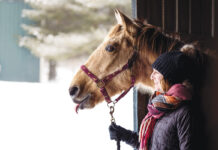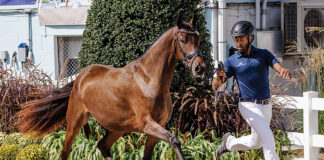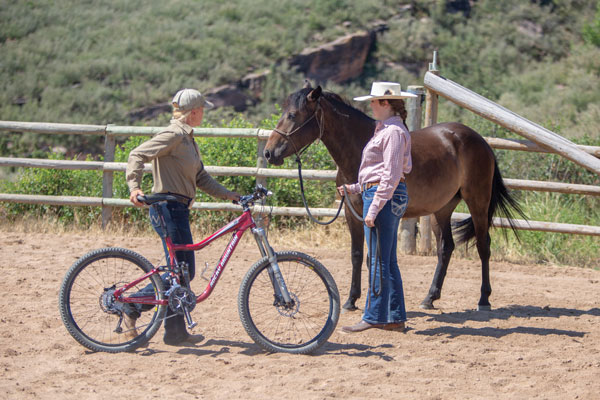
Have you and your horse ever encountered a speedy mountain biker on the trail? The buzzing sound of the bike’s spokes can be alarming and spook-inducing for your horse. While many bike riders share the trail as they should (bike riders should yield to horses and hikers), the mere presence of a bike can cause your horse to worry if the scenario is new. A bike in motion doesn’t move like anything seen in nature. Plus, the whirring wheels and squeaking brakes may be new sounds for your horse. Help your horse get used to the sights and sounds of a bike when you work at home in a controlled environment. If your horse is exposed to bikes and allowed to investigate and follow, he will soon feel comfortable encountering and being passed by bikes on the trail.
Arena Safety While Introducing a Horse to a Bicycle
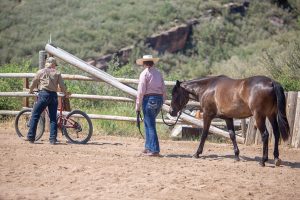
Follow First: Make sure your horse is outfitted in a rope halter and long lead. Ask your friend to walk beside her bike as she enters the arena. Ask your horse to walk beside you and follow the bike around the perimeter of the arena. Your horse will feel most confident when he is following the bike. Following the bike prompts his curiosity without making him feel trapped or pushed.
If your horse is nervous or refuses to follow the bike, allow more room between the bike and the horse. With a very fearful horse, you may start 100 feet behind the bike. If the movement of the bike is scary for the horse, move in slow motion.
Have your friend move the bike ahead 10 feet and stop; then ask your horse to move ahead 10 feet while the bike is stopped. Repeat this until the horse is more confident about the bike moving. Then resume following the bike while it’s in motion.
Also consider bringing in a seasoned, bike-confident lead horse to assist. The confident horse will follow the bike, and your nervous horse will follow him. Wherever the bike goes, the horses follow in a single-file line.
The lead horse acts like a buffer between the scared horse and the bike. As the nervous horse gets more confident, he can walk alongside the helper horse. Just make sure that each horse handler is in a safe spot should either of the horses spook. Have good spatial awareness and don’t put yourself in the spook zone (the space where a horse may quickly move if frightened).
If your horse is relaxed and willing to follow the bike in any direction, move on to the next step.
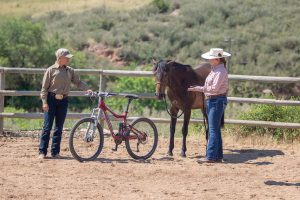
Stop: Ask your friend to stop walking beside her bike and allow your horse to move toward the bike and investigate. If your horse followed the bike with interest, he may be ready to check it out quickly. Allow him to sniff and touch the bike but be prepared if he spooks after moving a wheel or the handlebars.
If your horse stands still but doesn’t want to approach the bike, raise your left hand to point him toward it, gently swinging the excess lead rope to prompt him forward. If he takes a step forward, praise him and allow him to stop and sniff.
If his ears are forward and he shows interest in the bike, allow him to keep taking in information. If he looks away or wants to back up, ask him to step closer again.
Once his attention is on the target, be patient and wait for him to investigate the bike.
Passing: Ask your friend to walk toward you and your horse from the front. Ask her to walk slowly and move to the side of the horse where you’re walking.
Position everyone so that if the horse were to spook away from the bike, he’d also move away from you. Don’t put yourself in the area where your horse may move if he’s spooked—he’ll move away from the scary object.
Start the passing exercise with your horse as you carefully watch him for signs of nervousness. If you see him getting worried and you feel he may spook at the bike passing, have your friend turn the bike away from him before he has a chance to spook.
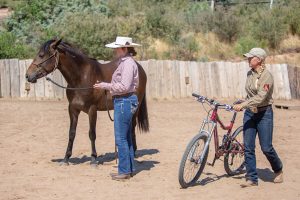
When he seems calm, allow your horse to follow the bike for a little while. By turning the bike away before he spooks, you’re building his confidence and showing him that it wasn’t a threat after all.
The goal is to make the bike seem less like a predator. When predators stalk their prey, they consistently move forward, rarely backing away.
Rear View: Your horse may feel the most threatened when the bike approaches him from behind. He can’t see it first to identify it, and the only way “out” is to run forward or quickly turn.
To simulate a bike passing you on the trail, ask your friend to approach your horse from the rear. If your horse gets worried, ask your friend to stop moving the bike forward. Allow the horse to turn and face the approaching bike. If your horse settles and relaxes once he sees that it was only the bike (that he is now familiar with), ask your friend to continue passing with the bike. Allow your horse to face the bike as it continues to pass by.
Return to the previous exercises (instead of continuing to approach with the bike from behind) if your horse still feels anxious. Work on turning to face the bike then following it as it moves away for as long as your horse needs until he’s relaxed and confident.
Remember to take it slow! A horse with a strong fear of bicycles doesn’t have to conquer it in a single session. It may take weeks or months of slow, confidence-building work to help a scared horse become truly confident. Know your horse, read his body language and fear level, and only do what you think he’s ready for.
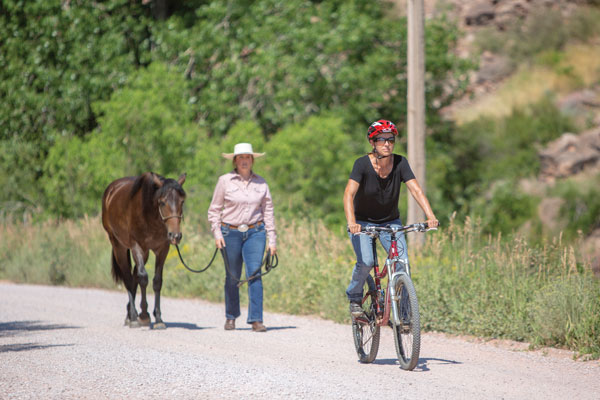
Road Practice
If your horse has followed, investigated and allowed the bike to approach him with no consequence, it’s time to try all the steps out in the open. Your horse may react differently when he’s also taking in new scenery on the road or trail. Practice on the road while you work from the ground before you test your horse as you ride. Your horse will be most confident when he sees you and knows how you want him to respond.
Once you feel confident about your horse’s lack of reactions and he consistently accepts the sight of the bike, it’s time to mount up and test your horse’s new training from the saddle.
Thanks to Luna Graham and her horse, Kali, for assistance with photos for introducing a horse to a bicycle.
Meet the Trainer
Trainer Jessica Dabkowski of Pony Peak Stangmanship in Laporte, Colo., focuses on natural horsemanship techniques while training Mustangs and all breeds of horses. She often works with young riders to help them prepare for Mustang Makeover competitions.
This article on introducing a horse to a bicycle originally appeared in the July 2019 issue of Horse Illustrated magazine. Click here to subscribe!

